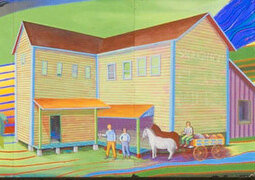PHOTO credit: ali eminov
In 1997, the City of Stoughton commissioned a mural celebrating Stoughton heritage to commemorate its sesquicentennial. Nationally reknowned artist Mel Butor portrayed images of the history, culture, and traditions of the community and the achievements of prominent Stoughtonites who laid the building blocks that have made Stoughton such a unique and wonderful community.
The northern end of the mural depicts Luke and Eliza Stoughton looking forward to the future of a community that will bear their name.
The southern end depicts stoughton’s future, our children, looking back on the highlights of our past.
the mill dam and saw-mill laid down and built in 1847
the flour mill built in 1850
Growth in trade and population was stimulated in 1853 by a new railroad depot and the inauguration of rail service
In 1858, the Universalist Church was built on land donated by Luke Stoughton. This was the first church in Stoughton and it now serves as the historical museum.
In 1865, T.G. Mandt began to manufacture wagons and sleighs as Mandt Wagon Works. The tradition of manufacturing vehicles for transporting goods is still carried on by Stoughton Trailers.
Per Lysne, a pin striper at the wagon works, went on to revive the art of rosemaling in the United States.
The rosemaling art form continues and is incorporated in the mural by this rosemaled plate designed by Ethel Kvalheim.
In 1864, tobacco replaced wheat as the predominant crop and Stoughton soon became the center of the tobacco industry in Southern Wisconsin.
Norwegian families who immigrated to stoughton with a dream, a rosemaled trunk, $8 for steamship passage, and a work ethic that soon made them landowners.
The Norwegian community also brought the sport of ski jumping to Stoughton - in the early 1900’s Stoughton’s 138 foot ski jump was purported to be the highest steel ski jump in the world.
By 1900, the Old City Hall on on Main Street was built.
The Roe House, built by O.K. Roe who served as Mayor of Stoughton at the turn of the 20th Century.
The Carnegie library, which has served Stoughton since 1908.
the Sons of Norway Viking ship float
Stoughton High School Norwegian Dancers
The Ward Hanson Memorial Band Shell
Mural Artist: Melvin Butor
Project proposed in 1996 by Jean Reek, founder of the Stoughton Norwegian Dancers
Project Director: Richard Lazzaro
Assistant Director: Richard Albright
Associate Director: Alan Zelm
Historical Research: Jean Reek, Lois Pieper
Funding provided by a grant from the Dane County Department of Cultural Affairs and contributions from the Stoughton Community
Mural structure courtesy of Zalk Josephs Fabricators
Mural unveiled on May 15, 1997 at the opening ceremony of the Stoughton Syttende Mai Festival



















